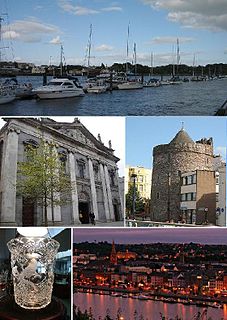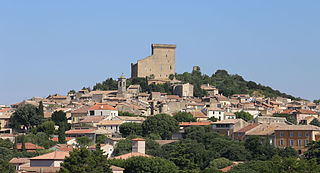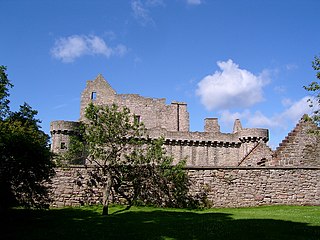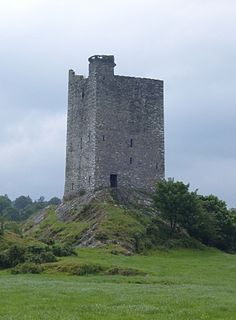
Waterford is a city in Ireland. It is in County Waterford in the south-east of Ireland and is located in the province of Munster. The city is situated at the head of Waterford Harbour. It is the oldest and the fifth most populous city in the Republic of Ireland. It is the tenth most populous settlement on the island of Ireland. Waterford City and County Council is the local government authority for the city. According to the 2016 Census, 53,504 people live in the city, with a wider metropolitan population of 82,963.

Castell Coch is a 19th-century Gothic Revival castle built above the village of Tongwynlais in South Wales. The first castle on the site was built by the Normans after 1081, to protect the newly conquered town of Cardiff and control the route along the Taff Gorge. Abandoned shortly afterwards, the castle's earth motte was reused by Gilbert de Clare as the basis for a new stone fortification, which he built between 1267 and 1277 to control his freshly annexed Welsh lands. This castle was likely destroyed in the native Welsh rebellion of 1314. In 1760, the castle ruins were acquired by John Stuart, 3rd Earl of Bute, as part of a marriage settlement that brought the family vast estates in South Wales.

Châteauneuf-du-Pape is a commune in the Vaucluse department in the Provence-Alpes-Côte d'Azur region in southeastern France. The village lies about 3 kilometres (1.9 mi) to the east of the Rhône and 12 kilometres (7.5 mi) north of the town of Avignon. In the 2012 census the commune had a population of 2,179.

The Maiden Tower is a 12th-century monument in the Old City, Baku, Azerbaijan. Along with the Shirvanshahs' Palace, dated to the 15th century, it forms a group of historic monuments listed in 2001 under the UNESCO World Heritage List of Historical Monuments as cultural property, Category III. It is one of Azerbaijan's most distinctive national emblems, and is thus featured on Azeri currency notes and official letterheads.

Kilcrea Friary is a ruined medieval abbey located near Ovens, County Cork, Ireland. Both the friary and Kilcrea Castle, located in ruin to the west, were built by Observant Franciscans in the mid 15th century under the invitation of Cormac Láidir MacCarthy, Lord of Muskerry, as protection from English troops.

Craigmillar Castle is a ruined medieval castle in Edinburgh, Scotland. It is three miles (4.8 km) south-east of the city centre, on a low hill to the south of the modern suburb of Craigmillar. The Preston family of Craigmillar, the local feudal barons, began building the castle in the late 14th century and building works continued through the 15th and 16th centuries. In 1660, the castle was sold to Sir John Gilmour, Lord President of the Court of Session, who breathed new life into the aging castle. The Gilmours left Craigmillar in the 18th century, for a more modern residence nearby Inch House and the castle fell into ruin. It is now in the care of Historic Environment Scotland as a scheduled monument.

Waterford city is situated in south eastern Ireland, on the river Suir [pronounced Shure] about seventeen miles (27 km) from where the river enters the sea. Practically the entire city is built on the south bank of the river. The "Old town", now the business centre, clusters behind the broad quay-front on a low-lying strip of land left behind by a gentle loop of the river at this point. From this, the land rises sharply to the east and opposite to the west while remaining level in between. The eastern slopes are almost entirely occupied by private residential estates, while the western and southwestern prominences are largely given over to local council housing development. There are corresponding elevations on the north bank eastwards towards Christendom and westwards towards Mount Misery.

York has, since Roman times, been defended by walls of one form or another. To this day, substantial portions of the walls remain, and York has more miles of intact wall than any other city in England. They are known variously as York City Walls, the Bar Walls and the Roman walls. The walls are generally 13 feet (4m) high and 6 feet (1.8m) wide.
Seán Dunne (1956–1995) was a poet born in Waterford, Ireland.

Carrigaphooca Castle, is a ruined five storey rectangular tower house situated on a steep-sided rock overlooking the River Sullane. It is located 6 km west of Macroom, County Cork, Ireland, in an area once known as Gleann na n-Dearg. The tower dominates the landscape of Lissacresig (Fairyland) in Clondrohid, and Lower Shanballyshane, in Kilnamartyra. Carrigaphooca is made of sandstone and limestone and was built as a defensive tower by MacCarthy clan member Donal MacCarthy of Drishane c. 1336-51.

Dunasead Castle, sometimes known as Baltimore Castle, is a 17th-century fortified house situated in the town of Baltimore in western County Cork, Ireland. The tower house is built on the site of an earlier Norman-era structure, which itself replaced an earlier Bronze Age ringfort. Traditionally associated with the O'Driscoll family, it was purchased and restored by members of the McCarthy family in the late 1990s, and partially opened to the public from 2005.

Ballinalacken Castle is a two-stage tower house located in Killilagh parish of County Clare, Ireland. It is of uncertain date but most likely was built in the 15th or early 16th century.
The 1977 Division I NCAA Men's Lacrosse Championship game was played at University of Virginia in front of 10,080 fans. Cornell capped off a 13-0 season with its second-straight NCAA championship as they defeated Johns Hopkins, 16-8.

Killilagh or Killeilagh is a civil parish in County Clare, Ireland. It contains the village of Doolin.

The French Church, a former Franciscan Friary and also known as Greyfriars Abbey it was built in 1241 on what is now Greyfriars and Baileys New Street, Waterford. At the entrance to the ancient church stands a monument to Luke Wadding, the famous 17th century Waterford born priest. This friary was one of the first to be built in Ireland, being founded by the Anglo-Norman Knight Sir Hugh Purcell.

Reginald's Tower is a historic tower in Waterford, Munster, Ireland. It is located at the eastern end of the city quay. The tower has been in usage for different purposes for many centuries and is an important landmark in Waterford and an important remnant of its medieval urban defence system. It is the oldest civic building in Ireland and it is the only urban monument in Ireland to retain a Norse or Viking name.

The Double Tower is one of the 17 towers which were part of the city walls of Waterford, Munster, Ireland. It was built in the latter part of the 15th century and the early part of the 16th century. Six of the original 17 towers survive to this day; the other five being Reginald's Tower, Beach Tower, Semi-Lunar Tower, French Tower, and Watch Tower (Waterford). The Double Tower is located on Castle Street, between the French Tower and the Watch Tower. All three towers are well-preserved, along with some parts of the old city wall between them.

The Watch Tower is a tower on Manor Street in Waterford, Munster, Ireland. It is one of the six surviving towers of the city walls of Waterford. The cylindrical shape of the tower suggests that it was built in the 13th century. The arrow slit openings, or embrasures, with a gun loop at the bottom indicate that the tower was modified in the 15th or 16th century to facilitate artillery operations. The tower does not have any windows on the city side; it was built solely as a defensive structure without a secondary use as a dwelling. At the rear of the tower there are two entrances, one at ground level and another at wall-walk level.

The Beach Tower located in Jenkins Lane car park, Waterford is a 15th century crenelated building which is part of the city defences. It was built on a rocky outcrop overlooking the River Suir and forms a natural defensive position.

St Sampson's Church lies on Church Street, in the city centre of York, in England. It lies on Church Street, near St Sampson's Square.


















